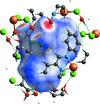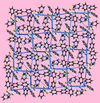issue contents
February 2020 issue

Cover illustration: In order to overcome the problem that short peptides are too flexible to be useful as therapeutics, specific modifications such as the introduction of biphenyl have been utilized. The crystal structure of the peptide-2,2'-biphenyl hybrid with the tripeptide Pro-Phe-Ala indicates non-planarity between each phenyl ring and the attached C=O function. The crystal packing is stabilized by O-H O and C-H
O and C-H O interactions with a water molecule and N-H
O interactions with a water molecule and N-H O=C and C-H
O=C and C-H O=C interactions between the peptide chains. See: Le, Nguyen, Nguyen, Mac & Bui [Acta Cryst. (2020). E71, 257-260].
O=C interactions between the peptide chains. See: Le, Nguyen, Nguyen, Mac & Bui [Acta Cryst. (2020). E71, 257-260].
research communications
Download citation


Download citation


The mixed alkaline-earth compound Ca0.84Sr0.16MoO4 has a typical CaMoO4 powellite structure. Its cell parameters fit well within the trends observed in similar powellites.
CCDC reference: 1973412
Download citation


Download citation


The syntheses and crystal structures of three compounds, 2,2′-[(2-nitrophenyl)methylene]bis(3-hydroxy-5,5-dimethylcyclohex-2-enone) (I), ethyl 4-(4-hydroxy-3,5-dimethoxyphenyl)-2,7,7-trimethyl-5-oxo-1,4,5,6,7,8-hexahydroquinoline-3-carboxylate (II), and ethyl 4-(anthracen-9-yl)-2,7,7-trimethyl-5-oxo-1,4,5,6,7,8-hexahydroquinoline-3-carboxylate (III), are reported.
Download citation


Download citation


In the title compound, C18H15ClN2O·H2O, the dihedral angle between the mean plane of the dihydronaphthalene ring system and the phenyl ring is 17.1 (2)°. In the crystal, molecules are linked by O—H⋯O, N—H⋯O and C—H⋯O hydrogen bonds.
CCDC reference: 1973816
Download citation


Download citation


Charge-assisted N—H⋯O and O—H⋯O hydrogen bonds along with π–π interactions stabilize the crystalline state. Intermolecular interactions are quantified by Hirshfeld surface analysis.
CCDC reference: 1974526
Download citation


Download citation


In the crystal structure of the title compound, molecules are linked through C—H⋯O hydrogen bonds and C—H⋯π interactions, forming chains parallel to the [010] direction. The molecular geometry in the ground state was been calculated using DFT. Additionally, frontier molecular orbital and molecular electrostatic potential map analyses were performed.
CCDC reference: 1974885
Download citation


Download citation


The title compound, [Na2(μ-C6F5BH3)2(C4H8O)4], represents a dimeric structure of sodium and organoborohydride, located about a centre of inversion. In the crystal, the molecules are stacked along the b axis via a π–π interaction between the benzene rings.
CCDC reference: 1973896
Download citation


Download citation


The title complex contains four distorted square-pyramidal molecules in the asymmetric unit, each of which interacts with another molecule located in an adjacent unit cell by means of two hydrogen-bonded water molecules of crystallization, thus forming symmetric dimers that govern the supramolecular features of the infinite lattice.
CCDC reference: 1974364
Download citation


Download citation


In the title tri-substituted thiourea molecule, a substantial twist is evident as seen in the dihedral angle of 65.92 (12)° between the planes through the CN2S residue and the 4-nitroaryl ring; an intramolecular N—H⋯O hydrogen bond leading to an S(7) loop is noted. In the molecular packing, O—H⋯O and O—H⋯S hydrogen bonds lead to supramolecular layers propagating in the ab plane.
CCDC reference: 1919879
Download citation


Download citation


The crystal structure of this novel adamantan-based compound is built up by organic chains formed and stabilized via C—H⋯π, N—H⋯S and C—H⋯S interactions.
CCDC reference: 1975689
Download citation


Download citation


Distinct tin coordination geometries are found in the title compounds, i.e. (C6H5)3Sn[S2CN(CH2C(H)=CH2)2] has a geometry intermediate between square-pyramidal and trigonal–bipyramidal, while the geometry for (C6H5)2Sn[S2CN(CH2C(H)=CH2)2]2 is based on an octahedron with cis-phenyl groups.
Download citation


Download citation


An intricate network of medium-strong O—D⋯O hydrogen bonds consolidates the crystal structure of water-rich K3PO4·7D2O.
CCDC reference: 1976170
Download citation


Download citation


The square-planar and trigonal–bipyramidal coordination environment around the Pt and As atom, respectively, each are distorted, with a τ5 value of 0.794 and 0.711 for arsenic in (1) and (2), respectively.
Download citation


Download citation


The transition-metal orthophosphate, AgSr4Cu4.5(PO4)6, crystallizes in an original structure characterized by two trimers [Cu3O12] linked by PO4 tetrahedra to form layers. The strontium and silver cations located between the layers ensure the cohesion of the crystal structure.
CCDC reference: 1975726
Download citation


Download citation


Upon recrystallization from ethylene glycol in daylight, (E)-5-phenyl-1-(pyridin-2-yl)pent-2-en-4-yn-1-one underwent spontaneous [2 + 2] cycloaddition reaction while (E)-5-(4-methylphenyl)-1-(pyridin-2-yl)pent-2-en-4-yn-1-one remained photoinert.
Download citation


Download citation


The title compound represents one of the hydrous alkaline earth thiosulfates with the lowest amount of crystal water known so far. The structure consists of layers, which are connected by weak hydrogen bonds.
CCDC reference: 1977322
Download citation


Download citation


The quinoline moiety of the title quinoline carboxamide derivative is not planar as a result of a slight puckering of the pyridine ring. The secondary amine has a slightly pyramidal geometry.
CCDC reference: 1879928
Download citation


Download citation


The title hydrazine carbodithioate features an almost planar C2N2S2 chromophore, which is close to co-planar with the terminal methoxybenzene group; the n-butyl group has an extended, all-trans conformation. In the crystal, centrosymmetric, eight-membered {⋯HNCS}2 synthons are formed by thioamide-N—H⋯S(thioamide) hydrogen bonds.
CCDC reference: 1977066
Download citation


Download citation


The crystal structures of the title compounds, two solvates (CHCl3 and THF) of a symmetric and highly substituted porphyrin, OBrTPFPP, are described. These structures each feature a non-planar porphyrin ring, exhibiting a similar conformation of the strained ring independent of solvent identity. These distorted porphyrins are able to form hydrogen bonds and sub-van der Waals halogen interactions with enclathrated solvent; supramolecular interactions of proximal macrocycles are additionally affected by solvent choice.
Download citation


Download citation


The cation [Se(CH2C(O)CH3)3]+ represents the first example for a cationic selenium compound with three ketone functional groups located in the β-position with respect to the selenium atom. The cation possesses almost trigonal–pyramidal C3 symmetry and forms hydrogen bonds to the ammonio group of the anion
CCDC reference: 1977644
Download citation


Download citation


The copper(II) ion has a distorted square-pyramidal coordination environment, achieved by four carboxylate O atoms in the basal plane and the water molecule in the apical position. The pair of symmetry-related copper(II) ions are connected into a centrosymmetric paddle-wheel dinuclear cluster via four O,O′-bridging 2-bromonicotinate ligands. In the extended structure, the cluster molecules are assembled into an infinite two-dimensional hydrogen-bonded network lying parallel to the (001) plane via strong O—H⋯O and O—H⋯N hydrogen bonds, leading to the formation of various hydrogen-bond ring motifs: dimeric  (8) and
(8) and  (16) loops and a tetrameric
(16) loops and a tetrameric  (16) loop.
(16) loop.
CCDC reference: 1977430
Download citation


Download citation


A novel trisubstituted arene compound bearing a pentafluorosulfanyl group (SF5) has been synthesized through a regioselective ortho lithiation, improved by the addition of a bidentate amine, followed by trapping with electrophilic I2. Incorporating the iodo group in 2-iodo-4-(pentafluoro-λ6-sulfanyl)benzonitrile strengthens the intermolecular interaction network with the cyano and pentafluoro substituents.
CCDC reference: 1943767
Download citation


Download citation


The synthesis and crystal structure of the title aryl sulfonamide are described. In the crystal, N—H⋯O and C—H⋯π interactions link the molecules, leading to the formation of a three-dimensional network structure.
CCDC reference: 1977684
Download citation


Download citation


The title molecule is planar with an r.m.s. deviation for all non-hydrogen atoms of 0.018 Å. An intramolecular O1—H1⋯O5 hydrogen bond involving the adjacent hydroxyl and nitro groups closes an S(6) ring motif.
CCDC reference: 1957893
Download citation


Download citation


In the title 1:2 co-crystal, 4LH2:2CBA, two independent three-molecule aggregates, i.e. 4LH2(CBA)2, are formed, each located about a centre of inversion and sustained by carboxylic acid-O—H⋯N(pyridyl) hydrogen bonding. The three-molecule aggregates are connected into a supramolecular tape by amide-N—H⋯O(amide) hydrogen bonding.
CCDC reference: 1978104
Download citation


Download citation


Analysis of the coordination of the Sn to the indenyl ring shows that the Sn interacts in an η2 fashion. A database survey showed that whilst this coordination mode is unusual for Ge and Pb compounds, Sn displays a wider range of coordination modes to cyclopentadienyl ligands and their derivatives.
CCDC reference: 1946071
Download citation


Download citation


The synthesis of the peptide biphenyl hybrid compound dimethyl 2,2′-[((2S,2′S)-2,2′-{[(2S,2′S)-1,1′-([1,1′-biphenyl]-2,2′-dicarbonyl)bis(pyrrolidine-1,2-diyl-2-carbonyl)]bis(azanediyl)}bis(3-phenylpropanoyl))bis(azanediyl)](2S,2′S)-dipropionate) is described. The crystal structure of this compound has a highly ordered supramolecular structure with extensive intermolecular hydrogen bonding.
CCDC reference: 1978230
Download citation


Download citation


A new pseudopolymorph of dodecachloropentasilane, namely a benzene monosolvate, Si5Cl12.C6H6, is described. There are two half molecules of each kind in the asymmetric unit. Both Si5Cl12 molecules are completed by crystallographic twofold symmetry. One of the benzene molecules is located on a twofold rotation axis with two C—H groups located on this rotation axis. The second benzene molecule has all atoms on a general position: it is disordered over two equally occupied orientations. No directions interactions beyond normal van der Waals' contacts occur in the crystal.
CCDC reference: 1979631
Download citation


Download citation


The structure of the title compound is held together by Ba—O—Ba bonds as well as by O—H⋯O hydrogen bonds of moderate strength. There is an occupationally as well as a positionally disordered molecule of propionic acid in the structure. Its occupation deviates from a potentially full occupation while the disordered molecules occupy two positions related by a twofold rotation axis.
CCDC reference: 1979831
Download citation


Download citation


The reaction of 1,3-dipyridyl-1,2-propane-1,3-dione (dppo) with nickel(II) bromide in HBr-acidified methanol produces a bromide salt containing the [(C13H11N2O2)(H2O)4Ni]+3 cation. The ligand is in its enol form— the O atoms bond to the nickel whereas the pyridyl N atoms are protonated as pyridinium rings. The nickel completes its octahedral coordinatin sphere by binding four waters. Three bromides balance the charge of the cation and there are two waters of hydration. The mean plane of the flat ligand makes an angle of 19.480 (17)° with respect to the plane defined by the nickel and its four equatorial O atoms. There is exstensive hydrogen bonding involving the anions, waters, and pyridinium N atoms.
CCDC reference: 1979583
Download citation


Download citation


The structure of a zinc porphyrin bearing a diazo ester group at the periphery of the porphyrin ring leads to a coordination polymer featuring ZnN4O square pyramids.
CCDC reference: 1968288
Download citation


Download citation


In the crystal structure of the title compound, the FeII cations are octahedrally coordinated into discrete complexes that are linked into layers via intermolecular O—H⋯O hydrogen bonding.
CCDC reference: 1980369
Download citation


Download citation


The title compound contains 1,4-benzothiazine and 2,4-dichlorophenylmethylidene units in which the dihydrothiazine ring adopts a screw-boat conformation. In the crystal, intermolecular C—HBnz⋯OThz (Bnz = benzene and Thz = thiazine) hydrogen bonds form chains of molecules extending along the a-axis direction which are connected to their inversion-related counterparts by C—HBnz⋯ClDchlphy (Dchlphy = 2,4-dichlorophenyl) hydrogen bonds and C—HDchlphy⋯π (ring) interactions. These double chains are further linked by C—HDchlphy⋯OThz hydrogen bonds to form stepped layers approximately parallel to (012).
CCDC reference: 1980073
Download citation


Download citation


Each metal cation in the molecular structures of [Mn(NCS)2(PM-TMA)2] (I) and [Ni(NCS)2(PM-TMA)2] (II) (PM-TMA is 2,4,6-trimethyl-N-[(pyridin-2-yl)methylidene]aniline) is situated on an inversion centre and is in a distorted octahedral coordination by six N atoms.


 journal menu
journal menu



















































